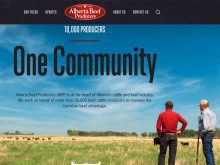LETHBRIDGE, Alta. — Farmers may have to hire a rainmaker if precipitation does not come soon to southern Alberta.
Irrigation areas that receive water from the Oldman River system will be in dire straits if no rain or snow falls by the end of this month.
The Rocky Mountain snowpack that replenishes the rivers is at 53 percent of normal.
“If we could get it to 75 percent, it would mitigate the severeness of what we’re looking at this year,” said Stan Klassen of the Alberta Irrigation Projects Association.
Read Also

Dennis Laycraft to be inducted into the Canadian Agricultural Hall of Fame
Dennis Laycraft, a champion for the beef industry, will be inducted into the Canadian Agricultural Hall of Fame this fall.
Last year, southern Alberta experienced the driest growing season since the dustbowl days of the 1930s. Back-to-back drought could be calamitous.
There is little or no subsoil moisture and storage reservoirs in the Oldman basin are low.
“The St. Mary’s and Waterton reservoirs are, for all intents and purposes, empty,” Klassen said.
The irrigation districts are looking at a number of scenarios if dry conditions continue. No decisions have been reached because there is still hope a heavy snow or rain will occur.
The worst case scenario is water rationing.
“Unless things really change drastically, we’re going to have to ration water,” he said.
“From the districts’ perspective, we have to try and make sure that what we do from one end of the district to the other treats water users fairly.”
Wally Chinn, an Alberta Agriculture irrigation specialist, said no one is pressing the panic button, but they want to be prepared no matter what the weather does.
“This is southern Alberta, and you don’t have a hope in hell of predicting anything,” Chinn said.
A number of actions are possible if rationing is necessary.
Allocation is determined by the date on the water licence, but abiding by the date may not be a wise decision.
For example, if a golf course has an older water licence than a piece of farmland, it would be politically disastrous to irrigate the fairways before the crops.
Sharing water is more likely than shutting off someone’s supply. As water supplies run short, it may be wise to determine how much is really needed to grow a crop.
Provincial irrigation legislation passed last year allows farmers flexibility when it comes to water use.
They are allowed to rotate water rights, and can move irrigation pivots from field to field to better fit crop rotations and deliver water where the need is greatest.
People may also be able to sell or trade water rights if there are shortages this summer.
Canals may not be filled to capacity and farmers might be advised against watering marginal land.
Some form of metering could also be used to control use.
Farmers may have to make some serious decisions about crop insurance.
No drought insurance is available on irrigated land, but Alberta Financial Services is considering secondary crop insurance if there is a water shortfall.
Farmers might consider moving water to high-value crops like alfalfa, sugar beets or potatoes, and growing cereals like barley as dryland crops. This might make the barley eligible for insurance if the crop fails.















